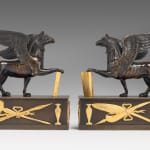In the manner of Alexis Decaix (c. 1753-1811)
A Pair of Regency Gilt-Bronze and Patinated-Bronze Griffin Paperweights
ENGLAND, CIRCA 1810
13.5 x 13.5 x 6 cm
5 ¼ x 5 ¼ x 2 ¼ in
5 ¼ x 5 ¼ x 2 ¼ in
7087
Further images
Provenance
Anonymous sale; Christie's, South Kensington, 13 February 2002, lot 463.With Jeremy Ltd., London
Collection of Philip Hewat-Jaboor (1953-2022)
One supporting a book and the other a scroll, the rectangular plinths applied with mounts of vases and ribbon tied implements and anchors. Another pair of griffins of the same...
One supporting a book and the other a scroll, the rectangular plinths applied with mounts of vases and ribbon tied implements and anchors.
Another pair of griffins of the same form as the present pair, but with ormolu griffins rather than patinated bronze, were part of the esteemed WiIdenstein Collection until sold at Christies, 14th-15th December 2005, lot 182. The various articles depicted on the plinths have classical and Masonic resonance. The anchor is a Masonic symbol of hope; first found on tombs among the catacombs located in Rome.
Alexis Decaix was the French immigrant 'bronze and ormolu manufacturer' of Rupert Street, Piccadilly, who was patronised by George Prince of Wales, later King George IV.
Another pair of griffins of the same form as the present pair, but with ormolu griffins rather than patinated bronze, were part of the esteemed WiIdenstein Collection until sold at Christies, 14th-15th December 2005, lot 182. The various articles depicted on the plinths have classical and Masonic resonance. The anchor is a Masonic symbol of hope; first found on tombs among the catacombs located in Rome.
Alexis Decaix was the French immigrant 'bronze and ormolu manufacturer' of Rupert Street, Piccadilly, who was patronised by George Prince of Wales, later King George IV.












